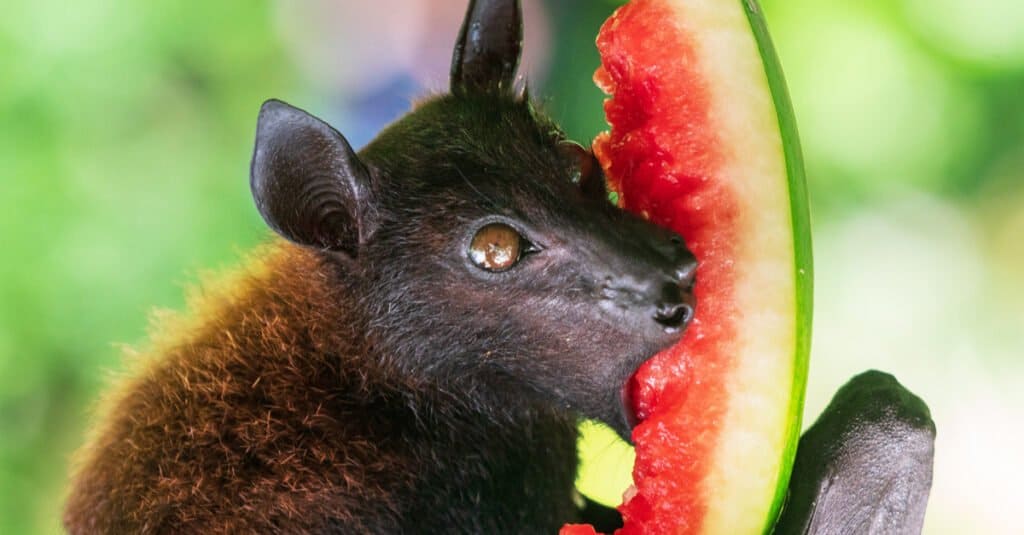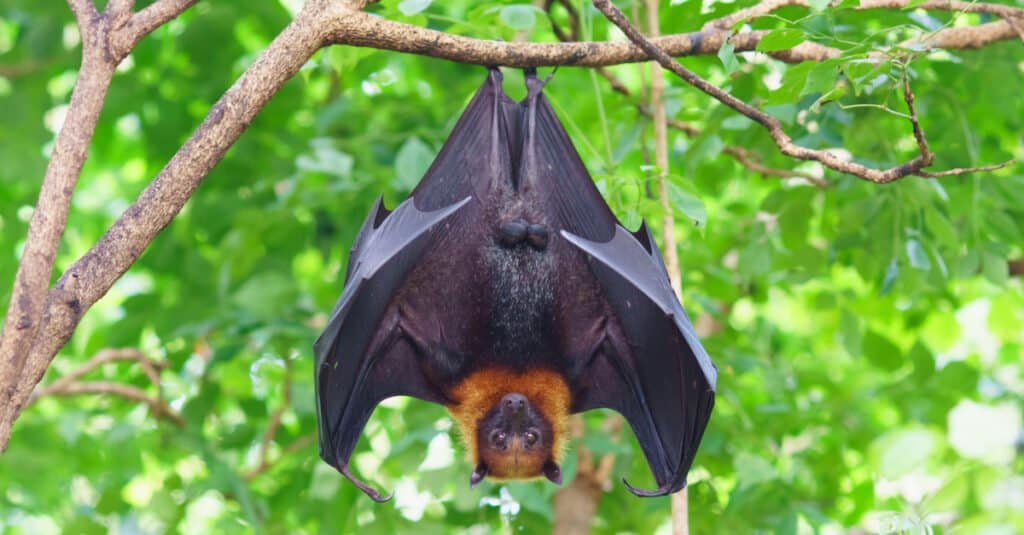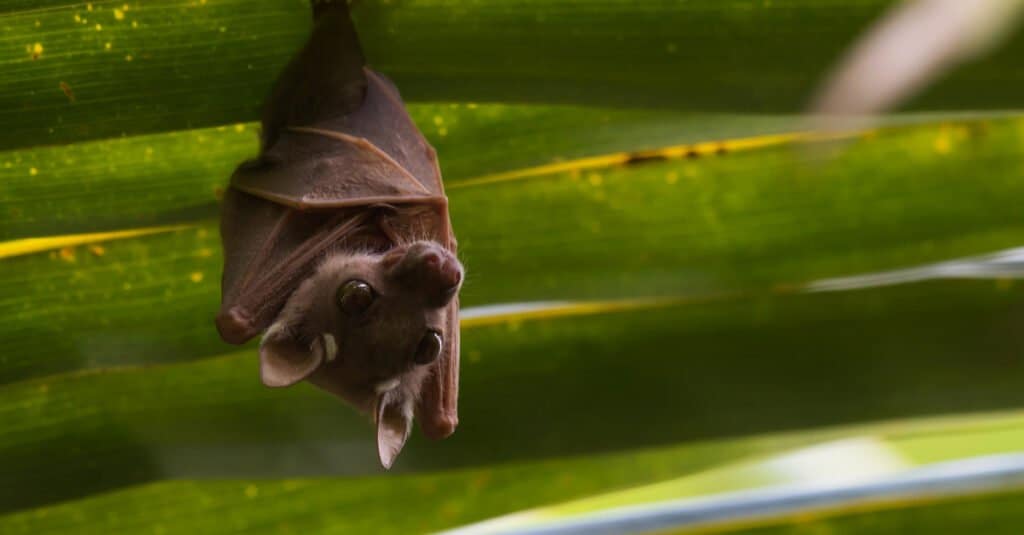Bats are amazing creatures that are found all over the world. Did you know that there are over 1,200 different species of bats? Of all the mammal species in the world, bats are the only ones capable of actual flight! Fruit bats are a large part of the bat population and play an essential role in our ecosystems, so let’s dive into those details and more. Here are ten incredible fruit bat facts that will blow your mind.

Anton Watman/Shutterstock.com
1. Bats by Another Name
If you saw a fruit bat up close, you might think it was a small fox with wings. These creatures are also known as flying foxes, thanks to their distinctive facial features. But despite their name, flying foxes or fruit bats are classified as megabats. This group of bats is characterized by their large size, with some species weighing over two pounds and growing up to 16 inches in length.
2. ‘Blind-As-A-Bat’ Does Not Apply
Most people think of bats as small, blind creatures that use echolocation to get around. However, not all bats are created equal. A whole subgroup of bats is known as megabats, including fruit bats. These bats are much larger than their microbat cousins and have the unique ability to see color. Color vision allows them to find ripe fruits more efficiently – hence their name.
In addition to their size and color sight, megabats also differ from microbats in that they do not echolocate. Instead, they use their brain’s visual centers and large eyes to navigate. These characteristics are critical during night-time foraging sessions and dawn/dusk flights when they need to be able to see where they are going.
3. Tree Growing Fruit Bats
Interestingly, fruit bats play an essential role in pollination and seed dispersal. Many scientists consider the Madagascan fruit bat (Eidolon dupreanum) as the sole pollinator of Madagascar’s rare baobab tree (Adansonia suarezensis). Additionally, their feces can serve as nutrient-rich fertilizers for plants. Consequently, certain plants and trees would not exist if it weren’t for fruit bats.
Given their critical ecological role, fruit bat populations worldwide are declining due to anthropogenic activity, such as habitat loss and hunting. Fortunately, much effort has gone into raising awareness about these fascinating creatures to protect them.
4. They Have Interesting Eating Habits
Amazingly, some fruit bat species can consume up to 2.5 times their body weight in fruit each day! While most of us wouldn’t be able to stomach that much food, fruit bats have a very high metabolism and digest their food quickly. They spend most of their night foraging to consume these vast quantities of fruit. Fruit bats may eat several small meals throughout the evening rather than one large one. Additionally, they don’t use their teeth to chew. Instead, they pierce the fruit and use their long tongue to suck out the contents. As you can see, these fascinating creatures have some pretty impressive eating habits.

jekjob/Shutterstock.com
5. We Know About Mothers’ Milk, But What About Fathers’ Milk?
For most mammals, making milk for their young is biologically the mother’s job. However, some species of fruit bats differ in this regard – amazingly, the fathers can also produce milk. Male Bismarck masked flying foxes and Dayak fruit bats have fully functional mammary glands that allow them to lactate.
So why have some male bats evolved the ability to produce milk? One possibility is that it provides an advantage in terms of caretaking. Since both parents can contribute to feeding their young, they can rear more offspring successfully. Whatever the reason, it’s clear that male bats are capable of much more than we might expect.
6. Long-Tongued Fruit Bat Facts
Fruit bats are an interesting bat species known for their long tongues. This phenomenon is an adaptation that helps them reach fruits deep in tree crevices and drink nectar from tubular flowers. When feeding is complete, they retract the tongue and store most of it in the chest cavity rather than in the mouth. This retraction helps keep the tongue moist and protects it from injuries. Fruit bats are important pollinators, and their long tongues help spread pollen to different parts of the trees. That’s pretty amazing.
7. Safety In Numbers: A Critical Fruit Bat Fact
Fruit bats live in huge colonies that can number in the tens of thousands. As it turns out, this tendency toward large groups may have an essential evolutionary purpose: safety in numbers. By huddling together in such large numbers, fruit bats can ward off predators, stay warm, and share vital information about food sources and other essential matters. In short, there is strength in numbers for fruit bats.

Dave Montreuil/Shutterstock.com
8. Naked Fruit Bats
There are many different types of fruit bats, and they live worldwide. Most species have fuzzy fur all over their bodies. However, there is a unique fruit bat, a species of the genus Dobsonian, that looks a little bit different from its cousins. These bats get their nickname ‘naked-back’ fruit bats because their wings attach near their spines, giving them the appearance of furless backs. While they may look strange, naked-backed fruit bats are fascinating creatures.
9. Tail-less Except for One
While all bats can fly, not all bats have tails. In fact, of the 46 fruit bat genera, only those in the genus Notopteris have tails. This remarkable diversity among bats illustrates the evolutionary power of natural selection. Over time, small changes in anatomy can lead to significant changes in function, allowing animals to adapt to their environment in unique and unforgettable ways.
10. Baby Fruit Bat Facts – Mom’s New Accessory
It’s not uncommon for baby animals to cling to their mothers for some time after birth. However, this behavior continues for up to four months for fruit bats. Fruit bats cannot fly when they are born. Instead, they cling to their mothers and rely on them for both food and shelter. Baby fruit bats feed on their mother’s milk, and as they grow, they gradually learn to fly and fend for themselves. In the meantime, it seems that the baby fruit bat will be an accessory for the mommy bat for quite some time.
Up Next – All About Bats
- Hoary Bat
- The Top 10 Largest Bats in the World
- Cutest Bat: Which Bat Species is The Cutest in The World?
- Baby Bat: 5 Pictures & 5 Facts
- Honduran White Bat
The post 10 Incredible Fruit Bat Facts appeared first on AZ Animals.
from Animal News, Facts, Rankings, and More! - AZ Animals https://ift.tt/o4umNKW